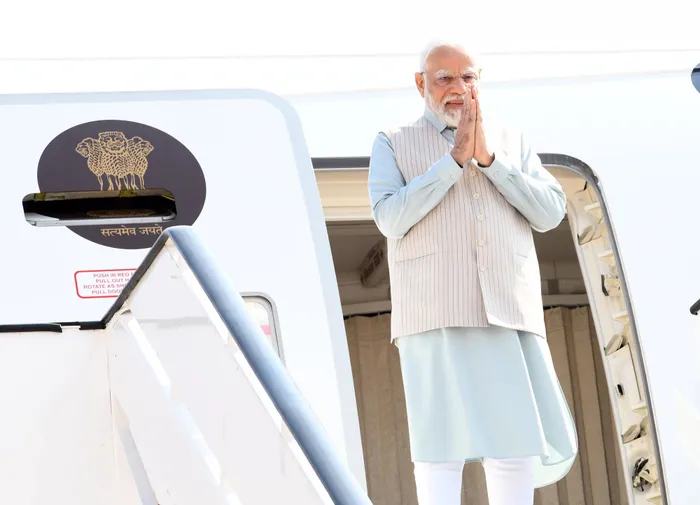Modi, leading India to new frontiers

Today, India stands on the cusp of being in the top three of the world’s leading economies, it is a world leader in technology and innovation, it is making strides in eliminating poverty and it views its status as the most populous country on the planet as an opportunity rather than a challenge. India's Prime Minister Narendas Modi is received by Deputy President Paul Mashatile after landing at the Waterkloof Air Force Base in Pretoria. Picture:Jacoline Schoonees/DIRCO
Dr Nereshnee Govender
India’s Prime Minister Narendra Modi's visit to South Africa for the 15th BRICS Summit also reinvigorates the historic bilateral and Struggle relationship shared between the two countries.
This year marks 30 years of diplomatic relations between India and South Africa. India was the first country to apply to the UN to impose sanctions against the apartheid government and its oppressive regime.
In those 30 years, India has transformed significantly and the transformation has been most transparent under the leadership of Modi.
Today, India stands on the cusp of being in the top three of the world’s leading economies, it is a world leader in technology and innovation, it is making strides in eliminating poverty and it views its status as the most populous country on the planet as an opportunity rather than a challenge.
What has contributed to India's economic rise, growth, innovation and transformation? India, with its 22 official languages and many dialects, is a complex country that operated in a largely cash-based society where money (termed “black money”) was not placed in banks.
Modi realised that for India to thrive, corruption had to be stemmed and capital would be needed to fund big government projects that would stimulate economic growth and provide funding to offer the poor and marginalised the dignity they needed.
This would also provide hope and aspiration so that future generations of Indian children could be educated and contribute to the innovation and technology that now drives the country.
On November 8, 2016, in a live broadcast to the nation, Modi declared that the country’s two highest-denomination currency notes (Rs 1 000 and Rs 500) would be withdrawn immediately from the market.
By making the notes worthless almost immediately, the government hoped to destroy large piles of black money hidden away by tax evaders. This was a major blow against corruption and counterfeiting and proved to be the catalyst for India’s transition into a digital, cashless world.
Since then, there have been massive gains in tax collections, and the country has progressed toward digital payments.
The introduction of the Direct Benefit Transfer (DBT) was yet another means to eliminate corruption – for decades, Indian citizens were denied facilities and opportunities and a gap was allowed to grow. This led to an competition to secure benefits over others and middle men had emerged who took advantage of long queues for gas connection, ration, payment of bills, admissions, licences and for any other request.
Long queues meant rampant growth of corruption impacting on the poor and the middle class of the country.
Through DBT government benefits are being passed on directly to the beneficiaries, in most cases eliminating the middleman and ensuring that the poor and middle class are not short changed.
The creation of skills development centres has offered hope to those who are unemployed. Those with high skills levels are encouraged and given bursaries to study at prestigious international universities, so they can return with knowledge and intellectual property that benefits their country.
Skilled professionals and business people are returning to the country in droves to set up businesses, under beneficial loans and incentive schemes, designed to increase employment.
Once a month, Modi does a television appearance called Mann Ki Baat Live (Speaking From The Heart) and encourages people to send him tips on how issues in the country can be addressed.
Those who know Modi say he works 16 hour days. This work ethic “for the greater good of the country” has been adopted by ministers and officials.
A prime example is Union Minister for Road Transport and Highways Nitin Gadkari whose department set a new Guinness World Record last year, laying 75km of bituminous concrete in a single lane on National Highway 53 in 105 hours and 33 minutes.
The total length of the 75 km of single lane continuous bituminous concrete road is equivalent to 37.5 km of two-lane paved shoulder road. The work started on June 3 2022 at 7.27am and was completed on June 7, 2022 at 5pm.
Progress in India can mean progress for others as the country wants to share its knowledge and expertise on its rapid infrastructure development and economic expansion with BRICS nations and the Global South.
South Africa and India’s relationship during difficult times and through diplomatic relations can best be summed up by the first democratically elected president, Nelson Mandela who, in 1995 in a speech delivered at the Indian Parliament, said:
“It is a history of shared commitment to freedom and democracy, to non-racialism and tolerance, to social equity and the eradication of poverty. It is a history of common experience of oppression and struggle for independence and freedom. It is a history of interdependence in struggle and mutual support.”
Dr Nereshnee Govender is an academic and a keen observer of issues related to international relations.